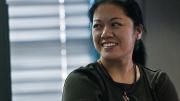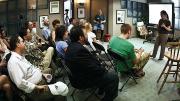On a recent trip to Yellowstone National Park, Charlene Li ’88, M.B.A. ’93, and her family took along some items to ease the 20-hour drive from their Silicon Valley home.
According to Li’s blog, Midnight Musings, the list included: three laptops with work files, movies, and her son’s favorite games (her daughter’s misbehaving iBook was left behind); two Nintendo DSs with wall and car chargers; two cameras, with chargers; a Treo and its car and wall chargers; a BlackBerry and BlackBerry mini-USB; iPod and Zune music players and their respective USB connector cords; a portable GPS (which broke down the second day, leading Li to joke, “We had to navigate with—gasp!—paper maps”); a Sony Ericsson/TMobile PC card for wireless access; and an iGo universal charger with interchangeable tips.
At the campsite, the octopus of electronics was left in the car—virtually unmissed. But upon leaving, the family spent the night in a Cody, Wyoming, hotel where Wi-Fi was offered in the lobby. “We gave ourselves an hour of quality Wi-Fi time,” Li reported, “but we also received several looks—and verbal disdain—from fellow travelers…to the effect of, ‘In my day, we wrote letters instead of all this fancy Internet stuff.’ My son took it in stride, and just declared the older gentleman was ‘not with it.’”
For Li, an authority on the interface between advertising and social networking, travel with such accoutrements is not only the norm—it’s the future. “Soon social networks will be like air,” she likes to say. “Your friends and the people you want to connect with will be everywhere and readily accessible.” The Cody scenario, she explains, was the result of being unconnected for five days of camping. “In Yellowstone we were completely cut off, not even a cell-phone signal,” she says. The hotel offered the chance to “totally geek out for an hour with all of our wires—and that’s when we got the comment. Some people may look at how connected my family and I are as a negative, that we don’t interact with ‘real’ people. But technology actually enables me to be more connected, to reach out beyond my daily work, home, and school routines and connect with people I know in unexpected ways.”
This new wave of technological socializing, of having hundreds—or thousands—of “friends” (the very definition is shifting), of sharing personal information more freely, of “being connected” 24/7, tends to push people’s boundaries. And that’s part of Li’s purpose; she is something of a digital-age provocateur in geek’s clothing.
Li first made a name for herself as a marketing analyst at Forrester Research Inc., where she covered media and technology; she has followed Google and Yahoo! from their inceptions. She was among the first analysts to push for and get her own company blog (in 2004), through which she dispensed news and analysis of current events, promoted reports, answered press questions, and communed with current and prospective clients—all of which established her professional identity while bringing in “significant revenue” for the firm.
Today, she speaks at conferences and counsels businesses, such as Sony, on digital strategies through her own fledgling company, Altimeter Group. Her views on the critical need for businesses to embrace social technologies—wikis, blogs, forums (threaded discussion boards), Twitter, Facebook, MySpace, YouTube, LinkedIn, and others—are spelled out in Groundswell, the 2008 business bestseller she wrote with Josh Bernoff, a vice president and principal analyst at Forrester.
Li specializes in what’s come to be known as Web 2.0—the next generation of Web development and design that “aims to facilitate communication, secure information sharing, interoperability, and collaboration” on the Web, according to Wikipedia, the free, online encyclopedia that perhaps epitomizes the best kind of virtual community.
But how can businesses tap into Web 2.0? The answers represent a massive paradigm shift for traditional sellers of goods and services, Li says. “I think of the old ways of advertising as yelling at someone, and if they don’t respond, you yell louder and more frequently in more places. Today, advertising is not about controlling and pushing a message. It’s about going out to the customer and saying, ‘Let’s talk...you got a problem we can help you with?’ It’s more of a personal, intimate conversation, building a relationship. And the key part is not just talking, it’s listening.”
She has had to adjust to the change herself. When she speaks at industry conferences, both in-house and online audience members are often Twittering to each other on what’s called the “back channel”—on laptops, BlackBerrys, and phones—while she is presenting. “Nobody is looking at you. It can be horrifying,” she says. “People are talking about you while you are talking, and laughing at something that you can’t see, and you are no longer in control of the situation.”
Yet she remains a passionate proponent of such scenarios. She reviews the “Twittered” feedback after the event to hone her own material—which is essential to her own business’s success. “Not everyone can take that kind of feedback—it takes a thick skin,” she admits. “But it’s like you have to give up control to be in control. And this way of doing business is very threatening to a lot of leaders because they see it as taking away their power.”
Li says H&R Block, on the other hand, has opted to engage with social technology by proactively seeking out anyone posting tax questions or holding tax discussions on Twitter, Facebook, and YouTube—and then joining the dialogue as experts. “The idea is, ‘We’re here to help: what do you need?’ versus ‘Come to our office!’ or promoting incentives to use their services,” she notes. “It’s a very different approach.”
Microsoft lets employees operate open-community, uncensored blogs and has even put up MIX, an online community for website designers and developers, and Channel 9, which reaches out to platform developers who freely commune with Microsoft’s own engineers. (Interestingly, she says, Apple is among those firms that are more resistant to employee-driven marketing, such as blogs.)
Southwest Airlines has assigned one of its schedule planners to blog about flight plans and field questions and complaints. “He’s someone customers know; he’s a face, he’s a person. They can go to him and know they will be directly answered,” Li says. The Discovery Channel has embraced fans who run wikis about individual episodes—creating new content and sharing news and resources. “They’re the ones who are passionate about Discovery,” Li says. “Why not let them do all the work?”
There is an immediacy and intimacy to this kind of customer relations that has not existed since business outgrew the mom-and-pop model, she adds—along with a level of unpredictability that many businesspeople aren’t trained to cope with. As she told a group of Google managers at a recent workshop: “You will always feel a little bit queasy if you are doing this right.”
“The traditional ‘org’ chart is becoming obsolete,” she explains. “The CEOs who see the opportunities and the employees who are involved love it. But middle managers are hating life right now because they are usually defined as the gatekeepers between the top layers and the bottom, and those roles are being redefined.” The revolutionary change is that social technologies are integrating customers “into the everyday process of how the work is done,” she reports. “They are a key part of running the business.”
Helping corporations make sound decisions within this vortical digital atmosphere takes hours of research and analysis—activities that Li has always enjoyed. In high school, she spent about eight hours a day practicing piano and doing homework. (She chose not to become a professional musician because the life was too socially isolating.) “I love to geek out on spreadsheets, data, financial reports. I do Sudoku and logic puzzles for fun,” she says. “My kids and I were talking about the difference between a nerd and a geek—we decided it was social skills. I’m a closet geek slowly coming out.”
In college, Li concentrated in social studies and wrote a thesis on American foreign policy toward dictators in Iran and the Philippines. Then she moved to Amsterdam to work for the consulting company Monitor.
There, she discovered an interest in technology; using the company’s ISDN line, which sent files and presentations to its other offices, she figured out how to communicate with a friend who had access to a UNIX terminal server. This was around 1991. In her second year at Harvard Business School, one “odd” professor had students send in their case studies by e-mail, which she found fascinating. She was one of only a handful in the class to pursue a job related to wired communications. Because she liked newspapers’ community focus, she decided to work for Knight Ridder, but insisted on a post at its San Jose Mercury News because “the hotbed of research was Silicon Valley,” she recalls. “I wanted to have direct impact in a small content company doing this wacky thing with the Internet. I was lucky that I was in the right place at the right time.”
In the next six years, Li married HBS classmate Côme Laguë, moved back to the Boston area (where she helped create and run online content for the Community Newspaper Company’s suburban papers), and had a baby. In 1999 she joined Forrester’s Boston office, and then moved with her family back to Silicon Valley, to join the local Forrester office, just as the 2001 Internet crash hit.
Her colleagues thought her nuts to spend time writing a blog, but Li pursued it, believing, correctly, that it would help ground her authority. “Women don’t...do enough in the branding area, perhaps because we don’t feel like we should be tooting our own horn,” she said in a recent interview with the career women’s magazine Pink (which dubbed her a “woman guru”). “I advise women, if anything, to trumpet from the hilltops how wonderful they are,” she added. “Use technology to do it. Hire a PR person or go out and do your own PR. Talk about it; go up to people and introduce yourself....That’s how I stand out.” Today, she has upwards of 12,000 followers on Twitter and thousands of fans and friends on LinkedIn and Facebook.
The open nature of social technologies has made her choosy about what she publicizes on her website, www.charleneli.com. “Privacy is a huge issue and no matter how you deal with it, you know not everyone is going to be happy,” she says. “Problems arise when information is being shared [with others] without transparency to the user.” Facebook’s Beacon program, part of its advertising system launched in 2007, was “not respectful of permissions and had poor control over when and how information and individual actions were shared,” she explains. “They quickly changed the program and have been working closely with Facebook members on the site’s ‘terms of service.’” But the controversy persists over privacy—as it probably always will.
“A company says, ‘Give us your income and your health information and we’ll give you free shipping’—and people will do that,” Li points out. “That’s how much we care about privacy. What we do value is control over that privacy.” To safeguard the public trust, “companies need to give consumers the ability to decide what information about themselves and their behavior is collected, as well as when and how it is used and shared,” she believes. “Social technologies amplify the need for trust even more. But this is the same situation we have been living with for decades.”
Li’s motto is “Share nothing I wouldn’t want to see on the front page of the New York Times”—including her address, her personal schedule and statistics, family news, weekend activities, her children’s information, etc. At home, the kids are limited to one hour of screen time a day (excluding homework requirements), and she and her husband adhere to a “no e-mail zone” between 6 and 9 p.m. All told, they have eight computers in the house. She does not blog religiously, and spends “maybe 10 hours a week” on Facebook and Twitter—although she does frequently add to her website and profiles. “I hear people complain, ‘I’m a slave to Twitter,’” she says. “But that is their choice. The real power we have as individuals is to turn it on and turn it off.”
After her family got their technology “fix” in the Wyoming hotel, “We shut it all down and went to see the rodeo,” Li says. “When we’re connected, we’re deeply connected. But there’s also a time and a place to be completely focused on the people in front of you, because it’s so seldom that you get someone’s full attention.”










